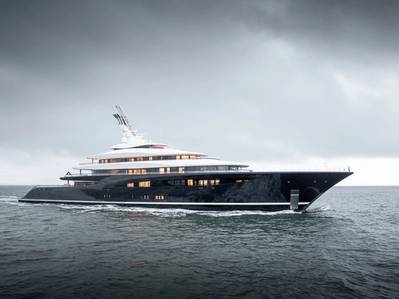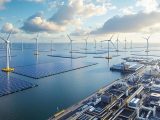
Hydrogen Fuel Cells Propel Zero-Emission Superyacht Breakthrough
August 12, 2025Dutch shipbuilder Feadship handed over the 118.8 m superyacht Breakthrough, a first-of-its-kind vessel driven by a multi-megawatt hydrogen fuel cell power plant. Built in the heart of the Netherlands’ shipbuilding scene, this yacht marries a liquid hydrogen fuel cell system with the ABB Onboard DC Grid, a sleek Power & Energy Management System (PEMS), twin Azipod propulsion units, plus shore connection and live diagnostics. The result? Up to a week of emission-free hotel services at anchor and whisper-quiet, zero-emission navigation at around 10 knots in harbors—talk about a game-changer in zero-emission technology. With ABB Ability Marine Pilot Control on deck, piloting and dynamic positioning become second nature. Initial sea trials are on the horizon, where Breakthrough will show off its chops from open seas to tight berths.
Market Impact
This tag-team between ABB and Feadship proves you don’t have to pick between luxury and sustainability. Ports tightening emission rules—some EU harbors are eyeing zero-emission berthing—mean hydrogen infrastructure is no longer sci-fi, it’s reality. The first liquid hydrogen bunkering in the Netherlands in June 2025 kicked off real-world rollouts. Marine insurers and class societies are circling, rethinking risk models for hydrogen fuel cells. Early adopters will nab the best reputations and breeze through new regs.
Strategic Partnership
Headquartered in Switzerland, ABB is a big name in electrification, automation and digital tech. Feadship, the Dutch consortium famous for crafting tailor-made superyachts, tapped ABB’s marine know-how to:
- Outfit the yacht with a 3–3.2 MW liquid hydrogen fuel cell setup for hotel services and slow-speed cruising.
- Install the ABB Onboard DC Grid to merge fuel cells, batteries and generators on one DC network.
- Deploy the Power & Energy Management System (PEMS) for smart energy planning and peak efficiency.
- Hook up two Azipod units for ultra-silent, smooth maneuvering.
- Enable shore power connections and remote diagnostics so ABB can monitor systems in real time and predict maintenance.
ABB’s digital ecosystem, led by ABB Ability, layers on analytics and firmware updates over the air, trimming lifecycle costs. Meanwhile, Feadship’s custom interiors keep the tech under wraps, so guests get all the comfort without a whiff of machinery—proof that cutting-edge decarbonization and plush luxury can go hand in hand.
Technical Snapshot
- Fuel cell rating: Reports range from 3 MW (Ship & Bunker) to 3.2 MW (MarineLink, Boat International). This liquid-cooled module sits right next to cryogenic tanks.
- Onboard DC Grid: A unified DC backbone slashes conversion losses and supports over-the-air updates.
- PEMS: Automated dispatch software that juggles supply, demand and voyage plans, keeping energy flow seamless.
- Azipod units: Steerable electric pods that trim noise, vibration and free up deck space.
- ABB Ability Marine Pilot Control: A user-friendly joystick interface for razor-sharp docking and dynamic positioning.
Note: Detailed specs for the fuel cells are still under wraps; we’re awaiting final word from ABB.
Key Takeaways
- First mover: Breakthrough is the world’s first superyacht running a multi-MW hydrogen fuel cell system—confirmed by multiple sources.
- Extended zero-emission ops: Up to seven days of hotel loads, plus 10 knots of silent harbor cruising on hydrogen.
- Infrastructure ramp-up: June 2025 saw the Netherlands host its first liquid hydrogen bunkering, spotlighting a real hydrogen infrastructure build-out.
- Decarbonization blueprint: A model for commercial vessels tackling IMO and EU emission targets through marine decarbonization.
- Luxury market shift: Marks the start of a green superyacht sub-market, fetching a premium among eco-conscious buyers.
Historical Context
Hydrogen fuel cells have powered small craft and pilot boats for years, but Breakthrough cranks that up to a >3 MW system. Feasibility studies kicked off in 2023, and June 2025’s bunkering required close work with Dutch authorities to nail down new safety rules—underscoring how edge-of-your-seat the hydrogen infrastructure build was. Previous hydrogen demos were mostly kilowatt-range or short-hop ferries; this superyacht raises the bar. It dovetails with global pushes by the Hydrogen Council and other alliances driving sustainable energy in shipping. As Jan-Bart Verkuyl, CEO of Royal Van Lent Shipyard and Feadship director, put it, “Breakthrough shows you can have top-tier comfort and responsible cruising in one package.”
Risks & Challenges
- Cryogenic storage complexity: Keeping liquid hydrogen at roughly −253 °C demands beefy insulation and smart design.
- CAPEX/OPEX premium: Fuel cells and cryogenic tanks still cost more upfront and in operations than diesel gensets.
- Source emissions: True zero-emission tech only shines with green hydrogen—gray or blue options cut into the benefits.
- Regulatory gap: Port safety rules and bunkering standards for large-scale hydrogen are still a work in progress.
- Certification hurdles: Insurance and class approvals for liquid hydrogen systems are fresh territory and could slow things down.
- Supply chain scaling: Broad adoption depends on cranking up hydrogen production, transport and distribution.
Expert Viewpoint
Seasoned maritime pros see Breakthrough as more than a showboat—it’s a floating R&D hub. Ports and fuel suppliers get a sneak peek at real-world zero-emission technology in action. Shipowners can tout carbon-neutral cruising as a marketable perk. Sure, sticker shock is real, but fuel cell costs are trending down, nudging total cost of ownership toward hybrid diesel-electric levels by decade’s end. Plus, fewer moving parts mean fuel cells could outshine combustion engines on reliability. That said, the crew behind the scenes has to wrestle with fuel taxes and port fees that haven’t caught up with hydrogen fuel cells bunkering yet.
Outlook
As ABB’s remote diagnostics and digital controls mature, we’ll move from fixing breakdowns to predicting them—shaving downtime and bills. If ports across Europe and North America build out refueling networks, we might see zero-emission, cross-Atlantic hops driven partly by hydrogen fuel cells. Shipyards could roll out retrofit kits, turning existing vessels into dual-fuel hybrids with minimal downtime. With EU regulators eyeing zero-emission berthing mandates, hydrogen-fueled vessels like Breakthrough could fast-track from niche novelty to industry mainstay, reshaping the maritime energy landscape. Expect a wave of MOUs among shipyards, fuel suppliers and ports in the next 12–18 months, turbocharging the hydrogen boom.
Closing
Breakthrough isn’t just another superyacht—it’s a lighthouse for marine decarbonization, proving that zero-emission technology and top-shelf luxury can sail together. Keep an eye on the horizon; the race to sustainable energy on the high seas is just getting started.



 With over 15 years of reporting hydrogen news, we are your premier source for the latest updates and insights in hydrogen and renewable energy.
With over 15 years of reporting hydrogen news, we are your premier source for the latest updates and insights in hydrogen and renewable energy.